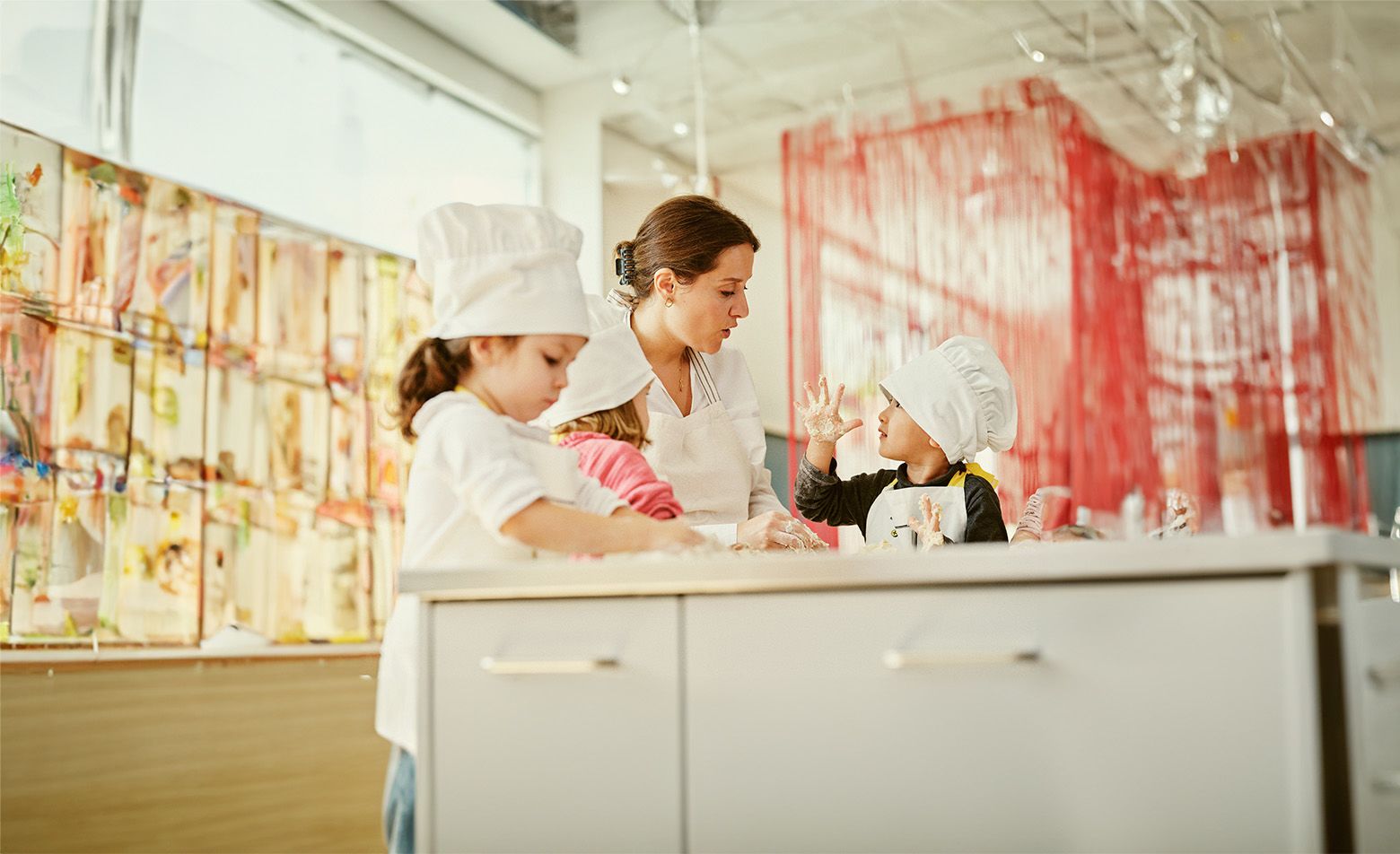Our traditions
From baking Grittibänz to the arrival of Samichlaus, Swiss traditions lie at the heart of your community - in school and beyond.

His eyes are often wonky, his belly misshaped and his legs bowed. Sometimes his outfit features elaborate detail, and other times it looks as though he may have no outfit at all. But, no matter what shape or size he might come in, nothing gets us in the mood for the holiday season more than the smell of Grittibänz being baked in kitchens across Zurich.
These little bread people, made with sweet dough, have been a traditional part of a Swiss Advent for as long as anyone can remember. At the Lower School, the youngest students mark the tradition by shaping and baking their own Grittibänz using dough prepared by parent volunteers – a festive addition to the weekly baking routine.
And Ritu Monga, a Lower School Parents’ Association (PA) member between 2014 and 2019, remembers the first year her children got involved in the Grittibänz tradition at school, when her youngest Arhaan Chadha (Grade 8) was in Preschool. “The kids ate all the raisins and chocolate chips so we didn’t have anything for the eyes,” she recalls with a chuckle. Grittibänz are still a favourite afterschool snack for Arhaan and his brother Ishaan Chadha, Class of 2026 (2013-21), though Ritu leaves the baking side of things to the professionals these days. “The ones they get from the shops have chocolate inside so they’re definitely more exciting,” she admits.
Students Sofia, Lucie, Daniel and Beatrice make Grittibänz with their teacher Marigona Buqa.
But Grittibänz is just one of the ways that Lower School students usher in the winter season. Another longstanding tradition is the Räbelichtli parade where students cheerfully make their way through the woodland next to the Lower School, lit-up turnip lanterns in hand, with the joyful sound of Swiss-German songs cutting through the chill evening air.
Ritu remembers the parade being “very sweet”, but she also remembers the event for the tremendous amount of hard work she put into it. Because every year, for the six years she was involved in the Lower School PA, she organised the hollowing out of 600 of those turnip lanterns, ready for the children to carve shapes in them. “That was not an easy task,” she says with a laugh. “The smell of those turnips! The parent volunteers and I would get dizzy with the fumes.”
Ritu says it was worth it, though, because it helped her boys feel at home in their new environment. “Sometimes it can be hard to integrate into Switzerland and this was such a nice way to do it,” says Ritu. “The school is a very welcoming, warm, international community, so it’s really special to be connected to the local community through these traditions.”
Then there’s Swiss Storytelling Night, held – in ZIS style – on the same evening as the parade. Begun in 1990, Storytelling Night sees primary schools and cultural venues across Switzerland hosting storytelling evenings. And at the Lower School they do things a little differently, as Lower School Principal Catherine Jolly explains. “We take it a step further! We want to show how we value all the languages spoken by the ZIS community so ours is a multilingual Storytelling Night.”
From German to Spanish and from English to Hindi, parents, teachers and students settle down in classrooms after nightfall with pillows and comforters brought from home to listen to all manner of stories. Naturally, cosy fires roar in digital hearths on the interactive whiteboards throughout the school. “It’s one of my favourite events because it’s just magical,” says Catherine. “It’s such a lovely thing that the families are there enjoying stories together.”




The school is a very welcoming and warm, international community, so it’s really special to be connected to the local community through these traditions
The Lower School was unable to host the joint Storytelling Night and the Räbelichtli parade in 2020 and 2021 due to the pandemic, so last year was particularly special. Three hundred families took part, “more than we’d ever had before,” says Catherine. “It’s an event the community has really embraced and wants to be part of.”
A little less than a month later, on 6 December, new faces appeared at the Lower School, in the shape of Samichlaus, Switzerland’s version of Santa Claus, and his black-clad helper, Schmutzli. As is traditional across Switzerland, the pair emerge from the woods, bringing treats for those who have behaved well, and reprimands – always gentle and firmly tongue-in-cheek – to those who haven’t.
“It was really exciting when they visited,” Arhaan remembers. No wonder. As his mum Ritu recalls: “The children were always amazed when Samichlaus knew all their names and what they’d been getting up to!” Ritu confesses that she wasn’t quite as amazed: as a member of the Lower School PA team she organised multiple sets of parents and school staff to dress up as the magical pair each year.
The December celebration is particularly special because so many families can relate to a similar tradition in their own culture, as Carol Rafferty Bouchard, mother of Lindsay, Class of 2013, and Colin, Class of 2015 (both 2006-9 and 2011-15) and an active member of the PA, recalls. “The kids enjoyed it and the parents enjoyed it. We probably had a party ourselves afterwards in fact!”
A special – and rather more involved – tradition for Grade 3 students is the Singing Christmas Tree. Every year, primary school children from across the Canton perform Christmas songs on a specially shaped stage on Werdmühleplatz, in the centre of Zurich. The performances take place over a month, and schools take their own slot. Donning green and red costumes before climbing up to the multi-level stage, students sweetly resemble bright baubles dangling on a tree.
“All the local schools come and we’re very much part of that tradition, but because we’re an international school, we will always sing songs in both Swiss German and other languages,” explains Catherine. “Zurich is a very cosmopolitan city, so it’s wonderful to see these students singing in Swahili and Spanish to Swiss German and English. It’s really lovely to be part of that.”
Carol’s children joined the school too late to take part in the Singing Christmas Tree themselves but she remembers the concerts with great fondness. “Christmas time in Zurich is so special – if I was going into the city I would always go by the Singing Christmas Tree. The kids who took part would talk to me about it when I visited the school and they absolutely loved it. Most would have seen it before it was their turn, so to then be part of something that they had seen was neat.”
It’s a wonderful way to prepare for the holiday season, and traditions like the Singing Christmas Tree, Räbelichtli and Grittibänz baking also provide meaningful opportunities for learning. “The German team, for example, can do some teaching up to these events to try to give the children the history and what they’re rooted in,” says Catherine. “We don’t want them to just be these events that happen – we want the kids to understand why they’re there, and why they’re important.”
The result of that understanding isn’t just educationally well-rounded students who are curious about their surroundings – though that’s certainly one of the outcomes of such a strategy. It’s also children and families who feel truly part of their local community. “You’re away from your own traditions and most of your family,” explains Carol. “Some years we didn’t go back to the US for Christmas. But you were there, in Zurich, and you were seeing the Grittibänz in the store, the Singing Christmas Tree, Räbelichtli, all of it, and it was a way to have these traditions, even if they were going to be transient. You felt grounded, part of the community that you were in.”
